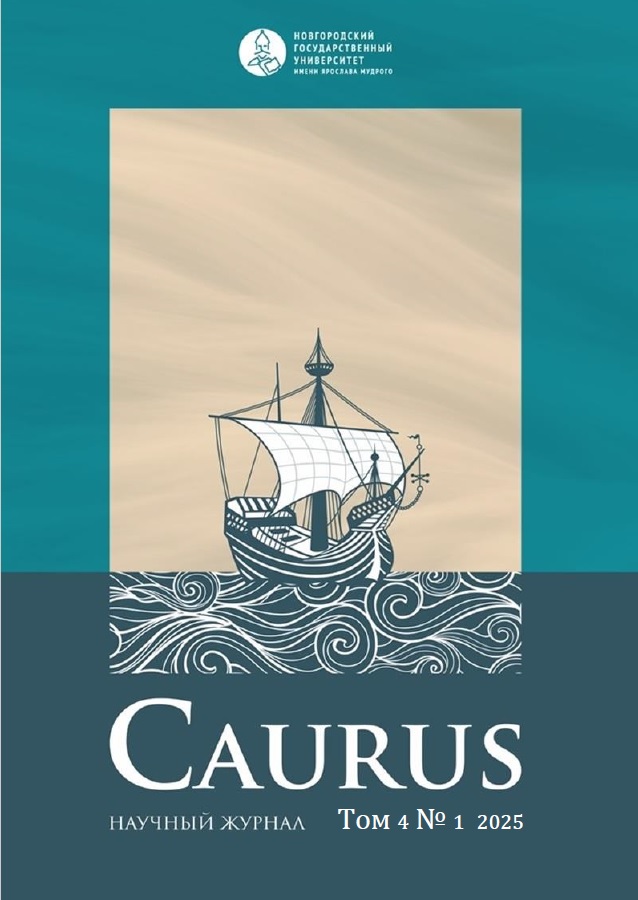Editor’s Foreword
Abstract
The main objective of the ‘Caurus’ journal, the next issue of which is offered to the interested reader, is to highlight and explore a wide range of problems concerning the medieval and modern periods of the history of the Russian North-West, mainly Veliky Novgorod and Pskov, and its closest western neighbours. All of them in one way or another had economic and/or geopolitical interests in the Baltic region, which has been an area of their intense contacts since time immemorial. The editors of the journal have no doubt that a careful and unbiased study of the historical roots of Russia's co-operation with the Baltic countries, Poland, Lithuania, Denmark, Norway and Germany makes a profound sense in our difficult times. Representatives of the brilliant assemblage of Soviet medievalists of the 60-80s of the last century represented the Western European Middle Ages as the time for formation of political, legal, economic and cultural foundations of the European society, which at the present moment, unfortunately, is seriously affected by the ‘dartre’ of destruction. The nature of this destructive phenomenon is yet to be clarified by historians, as, in fact, is the nature of Russia's conflicts with the countries of the Baltic region, which have subverted the situation there for centuries and have increased their explosiveness many times over in modern realities. It is possible to understand their essence by turning to their roots, plunging centuries deep into the depths of centuries, and to do this professionally, referring to historical sources and the entire fund of historiographical developments. Without performance of these duties, historical science is in danger of ‘sharikovshchina’[1] (‘And I do not agree...’) and an strangle of ideology-driven dilettantish constructions, which at the moment are already sprouting in the near-historical passages of popular television shows and publications.
Returning to the content of this issue, I would like to point out that a number of stories from the history of the individual countries of the Baltic Sea region refer us not only to their events, but also to the related historiography and historical sources – in short, to what makes ‘profane history’, as Augustine the Blessed once wrote, into a science proper. We should broaden our understanding of the historical development of countries and of the national characters of their peoples, so that we can apply this knowledge to the definition of their role in international relations and to the search for recipes for resolving the problems that arise there.
The complementation of historiographical and source (in this case archaeological) research is present in the article by S. A. Salmin and E. V. Salmina, members of the Archaeological Centre of the Pskov Region ‘Pskov, trading city outside trading routes: historical realities vs. historiographical tradition’. The authors note that despite the scarcity of written sources on the economic life of Pskov in the XIII-XV centuries, it is common for the Russian historiographical tradition to consider the town as an early and important trading centre of the Russian North-West of the so-called ‘Hanseatic period’. The material for reflection and the formation of a new approach to the identification of the trade importance of Pskov in the era of its independence (before 1510) are provided by archaeological excavations in 2011-2013 within the Novy Torg of Pskov in the first half of the XVI century, which emerged as the main trading area on the western outskirts of the Moscow state, which had a huge area and developed trade infrastructure. The authors of the article believe that the geographical position of Pskov outside the main continental trade routes may be one of the options to explain the rather late formation of its regular trade relations. As for the abundance of foreign artefacts from earlier centuries discovered during archaeological excavations, it is quite possibly explained by the existence of numerous, often extra-economic, contacts between Pskov, located in close proximity to the Russian-Livonian border, and the foreign countries in the Eastern Baltic. Only the global shift of trade routes, caused by the change of the political map of Eastern Europe, led to the increased importance of Pskov as an important centre of transit trade, gave impetus to the growth of trade areas, increased inflow of goods and funds to the city.
In the article ‘Individual judicial precedents between Russian and Hanseatic merchants in Narva during the first half of the 16th century as a source for studying the mechanisms of Hanseatic-Russian commodity exchange’ by V. A. Yakunina, a member of Yaroslav-the-Wise Novgorod State University, some aspects of Narva's foreign trade in the context of its economic relations with Livonian Hanseatic cities and Russian cities are being analyzed. In the process of studying a set of archival documents concerning the administrative and economic activities of the Order's bailiffs and the city magistrate, the author is interested not so much in the compliance of these activities with the normative guidelines or, on the contrary, in the methods of informal or ‘unusual’ trade, as in the nature of interaction between the two branches of the city administration in the sphere of legal regulation of trade entrepreneurship, which is presented taking into account the border specifics. The fragmentation and a certain kind of conflict-centricity of the historical material, which is mostly concerned with extraordinary situations, may raise questions about the legitimacy of the researcher to make inductive generalizations on such a rather shaky basis, as well as doubts about the objectivity of the knowledge obtained in this way. In constructing institutional and behavioral models characterizing the representatives of the Narva administration, descriptions of judicial precedents from various written sources were used, and in order to increase the reliability of the information contained in them, the author turns to the possibilities of descriptive statistics, which involves graphical presentation of the data available to the researcher and the construction of trends in the development of certain historical phenomena on their basis. As a result, the productivity of turning to judicial precedents as a means of studying the international trade of Narva and the participation of the city authorities in it increases significantly, in particular, a stable tendency is revealed in the interaction between the Order and city administrations in strengthening contacts with the Russian merchantry.
The article by L. I. Ivonina (Smolensk State University) ‘At the crossroads of politics: Janusz Radziwiłł and the union of Kėdainiai vs Sweden of 1655’ addresses the problem of the historical background of the popular and much-loved historical novel by Nobel Prize winner Henryk Sienkiewicz ‘The Deluge’, which tells about the tragic events of the Swedish invasion in the Polish-Lithuanian Commonwealth in 1655. It gives a detailed characterization and analysis of the actions of one of the most controversial politicians of the Polish-Lithuanian Commonwealth during its heyday, the Great Hetman of Lithuania Janusz Radziwiłł. H. Sienkiewicz gave his image the features of an ambitious adventurer and traitor to national interests and presented in frankly black colours the alliance (union) of the Grand Duchy of Lithuania with the Swedish King Charles X signed in Kėdainiai, which was directed against both Poland and Sweden's other powerful enemy, the Russian state. This interpretation of Janusz Radziwiłłł's activity became the property of Polish collective consciousness and Polish historiography for a long time, whereas the author of the proposed article has considered it possible for himself to abandon bias against the Great Hetman and explain his Swedish policy by a number of objective circumstances, first of all, by the political order of Lithuanian magnates and gentry in the part of the Grand Duchy of Lithuania captured by the Swedes, who sought equality with the Polish elite and defense of their power prerogatives against attempts from outside the Grand Duchy of Lithuania. Thanks to a comprehensive selection of historiographical data and detailed coverage of the historical context of Radziwiłłł's policy, it no longer seems like an adventure, but the result of a difficult choice he made in the face of an extremely difficult international situation. In case the terms of the union of Kėdainiai were implemented, there was a real threat of denunciation of the Polish-Lithuanian Commonwealth and its dissolution, which, however, was avoided due to the political split in the ranks of the Lithuanian nobility, some of whom opposed the union of Kėdainiai and, due to objective circumstances, remained loyal to the Polish king.
The article by M. B. Bessudnova and A. A. Lebedeva (Yaroslav-the-Wise Novgorod State University) ‘Shedding light: the “Bergen games” in Hamburg and Bergen’s sources’. The subject of the study here are two manuscripts from the archives of Hamburg and Bremen, concerning one of the aspects of life of the Hanseatic bureau in Bergen (‘German Bridge’) of the XVI-XVII centuries, namely, the rite of admission of merchants to the circle of its guests, which became known as the ‘Bergen games’. Western European historians wrote about them at the end of the XIX and the first half of the XX centuries, using mainly the Hamburg manuscript, while the manuscript monument from Bergen, published in 2001 by A. Nesse, allows us to supplement our ideas about the ‘games’ and partly clarify the question of their purpose, which is still not fully resolved. The brutal water, fire (smoke) and lashing tests practiced in them were meant to test the Hanseatic merchant's fortitude and to confirm his ability to withstand any trials he might encounter as a ‘long-distance merchant’. This peculiar initiation was a direct consequence of Hanseatic customs, according to which each merchant, as a participant in the commercial enterprise, was personally responsible for the safety of the lives of his companions, their goods, the ship or the trading yard. Most of the tests carried out in Bergen were not so cruel and were aimed at finding out the purely economic skills of a newcomer, related to cooking, putting the bureau in order, weaving ropes, etc. All this was predetermined by the absence of women there and, as a consequence, by the merchants' obligation to take care of the domestic side of their stay at the Bergen bureau themselves.
The issue concludes with a presentation of a project related to the translation into Russian and publication of J. W. Ruuth's classic work on the history of Vyborg (Johan Wilhelm Ruuth’s History of Vyborg: A Century-Long Wait for Translation) by A. V. Mel’nov, O. V. Kostanda, and S. A. Kuprik of the Vyborg United Museum-Reserve. Taking into account the important role that Vyborg has played over the centuries in the development of international contacts between the countries of the Baltic region, including Russia, and the relatively small number of monographic studies on this topic, the appearance of the Russian-language edition of Ruuth's book, which covers a variety of problems from the history of the city and during the last century has repeatedly provided material for researchers, will certainly be duly demanded by Russian readers.
M. B. Bessundova
[1] ‘Sharikovshchina’ in Mikhail Bulgakov's story ‘Dog's Heart’ is a dangerous and destructive social phenomenon associated with post-revolutionary changes in society.







